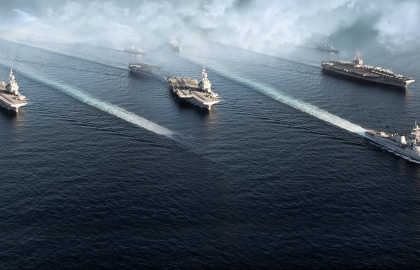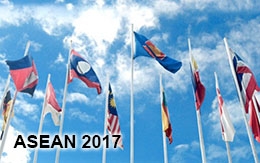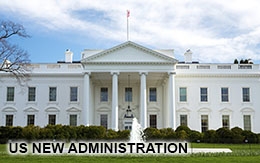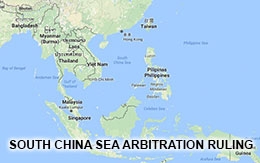The South China Sea after the Arbitral Tribunal
Without law to support its position, Beijing would resort to power to demonstrate control over the South China Sea, not only to exclude external powers such as the US but to intimidate the ASEAN claimants into an acknowledgement of Chinese sovereignty.

The Arbitral Tribunal’s ruling has changed the situation in the South China Sea in unexpected ways. On 12 July 2016, it ruled that China may have had historic rights to the resources of the South China Sea, but “such rights were extinguished to the extent they were incompatible with the exclusive economic zones provided for in the (Law of the Sea) Convention.” The Tribunal also noted that there was no evidence that China had actually exercised exclusive control over the South China Sea or the resources there. Secondly, the Tribunal found that none of the features in the Spratly Islands is capable of generating extended maritime zones, including those occupied and artificially reclaimed by China. Some commentaries derided the result as being essentially irrelevant to China and its attempt to control the South China Sea. In one such commentary Graham Allison, director of Harvard Kennedy School’s Belfer Center for Science and International Affairs, opined an essentially realist position claiming that law was irrelevant to the great powers who conducted their affairs without reference to it. He argued that in ignoring the verdict “Beijing is following well-established precedent by great powers,” and that international law is “only for small powers.” Predictably, China’s Ministry of Foreign Affairs declared that the ruling of the Arbitral Tribunal is “null and void and has no binding force, China, it said, neither accepts nor recognizes it.” The Ministry added that “the Chinese government will continue to abide by international law and basic norms governing international relations” which meant that China would decide what it would abide by, and what it would ignore.
Without law to support its position Beijing would resort to power to demonstrate control over the South China Sea, not only to exclude external powers such as the US but to intimidate the ASEAN claimants into an acknowledgement of Chinese sovereignty. In this respect, China’s actions indicate a consistent effort to obtain ASEAN acceptance of Chinese sovereignty over the area in a regional resolution of the dispute which would then be declared legal, while the Arbitral Tribunal’s ruling would be consigned to history as a western misunderstanding of the situation there. The resort to power would result in a deterioration of security not only in the South China Sea but in the East China Sea and the Korean Peninsula. Chinese Ambassador to the US Cui Tiankai declared that the ruling will "intensify conflict and even confrontation," and will “undermine and weaken the motivation of states to engage in negotiations and consultations for solving their disputes."
China’s reclamation projects
China’s reclamation projects in the Spratly Islands are central for the above purpose of demonstrating control of the South China Sea. Since August 2014, the Chinese have been dredging sand from the ocean floor and extending the size of Fiery Cross, Johnson South, Subi, Cuarterton, Gaven, Mischief, and Hughes reefs. These projects may be a response to the Philippine appeal to the Arbitral Tribunal, particularly as the Chinese failed to sway the Aquino Administration from its invocation of law. If so, then the projects are an acknowledgement of China’s legal weakness and preparation for what the Chinese would regard as an adverse decision by the Arbitral Tribunal. In any case, China has constructed three airfields in the Spratly Islands; one in Fiery Cross Reef at 3,000 meters, another on Subi Reef also at 3,000 meters, and a third runway on Mischief Reef at 2,600 meters. These airfields will be able to support Chinese air superiority fighters as they are deployed from Woody Island in the Paracel Islands group, some 800-1000 kilometers to the North. According to Asia Maritime Transparency Initiative (AMTI), which closely monitors the situation, China has constructed hangars for 24 fighters as well as for transport and maritime surveillance aircraft. Mobile missile launchers have also been deployed there. AMTI surmises that the facilities on those three reefs with airfields interlock so that China’s military aircraft would cover the entire South China Sea. With enhanced radar coverage China could then attempt to exclude the US navy and raise the risk for American Freedom of Navigation Patrols (FONOPs) which have been conducted in the area since October 2015. China would then be in a position to declare an ADIZ, as it did in the East Sea in November 2013, as a demonstration of sovereignty.
The Chinese claim that these military facilities are required to defend the features they had occupied. Dai Bingguo, who was State Counselor to Hu Jintao, stated in a speech in Washington on 5 July 2016 that “we have never claimed we own the entire South China Sea.” He explained that these reclamation projects were intended to prevent “further tragic losses of territory.”
This is unconvincing, however, since the projects were initiated at a time when there was no threat to the Chinese position, and no possibility of any tragic loss of territory. American FONOPS as executed under the Obama Administration were a response to these reclamation projects and their cause. A report from Kyodo News Agency referred to an internal publication of the PLA drafted by officers of the Navy’s South Sea Fleet, which claimed that China had secured the “central leadership role” and “military supremacy” in the South China Sea. The report noted that regional claimants and neighboring countries were “intimidated by the projects” and unlikely to provoke any military conflict because they are “too poorly prepared.” The report added that the reclamation projects had given a strategic advantage to China in what it called “endurance warfare.” In this form of warfare the PLA had taken advantage of a “civilian front” to extend its reach in the South China Sea. “Endurance warfare” entailed the use of fishing vessels and coast guard ships to ratchet up the pressure on the ASEAN claimants, depriving them of any hope that they could seek support from the Tribunal. It brought to bear low level pressure on the claimants without the resort to overt force which would provoke an international outcry and trigger an American response. It was intended to press the ASEAN claimants into an acceptance of the Chinese position in the South China Sea by playing on their fears that America would be helpless and unable to react.
ASEAN reactions
Indeed, China has successfully unsettled the Philippines and Malaysia where the leaders of both countries have moved to make peace with Beijing in a gesture of supplication to superior power. The new President of the Philippines, Rodrigo Duterte, was elected on 16 June 2016, four weeks before the Arbitral Tribunal announced its ruling. Duterte has declared that he would bandwagon with Beijing while threatening to break ties with the US, the ally of the Philippines. The Chinese demanded that Duterte set aside the Arbitral Tribunal’s ruling and Foreign Minister Wang Yi warned him that there would be “confrontation” if Manila insisted on the ruling. On a visit to Beijing in October 2016, Duterte announced his "separation" from the US and declared that he had realigned with China. He also said that he would “set aside the ruling,” while castigating the US Ambassador for not responding to Chinese activities in the South China Sea. Despite his rhetoric Duterte has not so far as to break ties with the US, nor has he actually set aside the Ruling. He has defused Chinese hostility without actually tying his hands and has obtained promises of economic aid from a Beijing which has attempted to detach him from the US. China has committed to finance at least three infrastructure projects in the Philippines worth $3.4 billion, and has promised to import up to $1 billion worth of Philippine agricultural products. So far, Duterte has used confusion to his advantage but whether he would be able to continue in this way is very doubtful as Beijing undoubtedly will demand a clear commitment before these economic promises will be realized. In an interesting development in March 2017 Manila announced that direct talks will be conducted with Beijing over the South China Sea. Foreign Secretary Perfecto Yasay justified Manila’s acceptance of the Chinese demand by saying that it was better to set aside the maritime dispute with Beijing and engage it to avoid an armed confrontation. China has effectively used the Philippine fear of confrontation to ease Duterte into an attitude of defeatism where the Arbitral Tribunal’s ruling might be exchanged for an uncertain peace with China, which Beijing could revoke at any time.
Malaysians had claimed a special relationship with China hoping that it would protect them from Chinese pressure in the South China Sea. They were prepared to tolerate Chinese incursions in their claim area which had been continuing on a regular basis because of their reluctance to disturb this special relationship. Chinese incursions into Malaysia’s claim area have been increasing. In June 2016, Chinese coast guard vessels forced out Malaysian patrol boats from Luconia Shoal in Malaysia’s EEZ and escorted about 100 Chinese fishing vessels into the area. Malaysia’s Prime Minister Najib Razak visited Beijing in November 2016 expecting that business deals with China would overshadow the scandal that had erupted over the misappropriation of funds from 1Malaysia Development Berhad (1MDB). In Beijing, Najib agreed to purchase four Chinese naval vessels for inshore patrols, two of which were to be manufactured in China and two in Malaysia. Najib had hoped to return in triumph from Beijing but former Prime Minister Mahathir accused him of surrendering Malaysia’s claims in the South China Sea to China. Mahathir’s accusations were ironic because he had encouraged the belief in Malaysia’s special relationship with China while he was in power. The special relationship was supposed to act as a constraint upon China but it may have the unintended effect of socialising Malaysian leaders into an acceptance of China’s dominant position in the South China Sea. Where that would leave Malaysia’s own claim and the Petronas’s oil fields is a disturbing issue for the country’s leaders.
Chinese efforts to secure ASEAN endorsement of its position in the South China have been assisted by Duterte, and to a lesser extent Malaysia. However, it would be premature to say that the regional association has been brought under Chinese influence, or that it would accept Chinese sovereignty in the South China Sea. Both Vietnam and Indonesia have braced themselves for greater Chinese pressure and are likely to resist it while avoiding open conflict. Vietnam has responded characteristically by conspicuously sidestepping controversy which would provoke the Chinese while reinforcing its own position in the Spratly islands. Vietnam has constructed its own military facilities on Spratly Island where it has extended the runway there from 800 to 1,300 metres. It has built two new hangars on this feature to accommodate small military and marine surveillance aircraft. This runway was originally built for STOL (short take-off and landing) aircraft for resupply, a far cry from the 3,000 metre runways built by the Chinese on their features. Reuters reported that Vietnam had deployed 306mm guided rockets to five reefs in the Spratlys which were close to Chinese installations there. Vietnam was also in the process of forming a combined air and naval brigade for maritime patrol, search and rescue, and troop transport. In March 2017, Vietnam also took delivery of the last two Kilo class submarines which it had ordered from Russia in 2009 at a total cost estimated at $3.2 billion. Vietnam now has six Kilo class submarines and though it has no experience of handling submarines, they would have some deterrent value against China. Vietnam regularly dispatches its leaders to Beijing to affirm party to party ties in the hope that they would bind the Chinese leadership to good relations with its fraternal partner in Hanoi. Vietnam’s General Secretary Nguyen Phu Trong visited Beijing twice already in October 2011 and April 2015 to affirm these ties between the two parties, his third visit took place in January 2017. Since their clash in March 1988 China has avoided Vietnam in its island seizing strategy and has targeted the Philippines. This may be related to the party to party ties with Vietnam which China intends to preserve, and also to recognition of Vietnam’s military capability and willingness to defend itself.
Though Indonesia describes itself as a non-claimant in the South China Sea it has become increasingly involved as Chinese fishing vessels and Coast Guard ships intrude into the waters around the Natuna Islands. Indonesia has attempted to forge an ASEAN consensus over the South China Sea which has, however, constantly eluded its diplomats as the group’s non-claimants such as Cambodia and Laos avoid the issue. ASEAN has been disappointing for Indonesia which has fortified its position in the Natuna Islands by upgrading military facilities at Ranai on Pulua Natuna Besar to support the docking of larger vessels. It also intends to build its third submarine base on the island, one such base is in Kalimantan and the other in West Papua. Indonesia has two active Cakra class submarines which were purchased from Germany, while three other submarines from South Korea are on the way. The Indonesian navy has also sought US Foreign Military Finance (FMF) to upgrade its naval facilities close to the South China Sea. Indonesia has participated in the American sponsored annual bilateral military exercise called Cooperation Afloat Readiness and Training (CARAT) since 1995. As a message to China, in October 2016 Indonesia conducted its largest military exercise ever around the Natuna Islands involving all three services called Angkasa Yudha. Poignantly, the navy’s attempt to launch the Chinese made C-802 anti-ship missile were an embarrassing failure.
Some media commentaries claim that China has won the game because the Tribunal’s ruling is unenforceable and Beijing has attained a dominant position in the South China Sea from which it cannot be removed. They claim that ASEAN will fall under Chinese influence as China demands acceptance of its version of a Code of Conduct (COC) for the area. In March 2017 the Chinese announced that a final version of the COC was being negotiated with ASEAN which would prohibit the introduction of “offensive” weapons into the South China Sea, a reference to American FONOPs, while “defensive” weapons would be permitted, which would allow China to maintain its military facilities there. Philippine Foreign Minister Perfecto Yasay thought that a framework for a COC could be in place by June 2017 but he was being optimistic. ASEAN cannot agree on the issue and the claimants are unlikely to accept a Chinese proposal that would prevent them from obtaining external support, in which case there would be two possible outcomes. One is a bland restatement of the Declaration on the Conduct of the Parties in the South China Sea (DOC) which was concluded between ASEAN and China in 2002, the other is a face saving declaration that would allow negotiations to drag on as they have done before. The latter is more likely.
The impact of law
Law may be ignored by the great powers but not with impunity as it has the effect of clarifying situations and identifying rights and responsibilities. The Arbitral Tribunal’s ruling will not simply fade into the past as the Chinese hope and it will stimulate a convergence of views amongst external powers whose concern is for a rules based regional order that would bring about greater security and predictability. Should blatant non-compliance occur in a contested situation relating to the balance of regional power opposing coalitions may be generated to the detriment of the non-compliant state. Russia’s seizure of the Crimea in 2014 was such a blatant disregard of the sovereignty of the Ukraine which came with certain consequences as it crystallized views of Russia as an expansionist state and facilitated cooperation against it and support for the Ukraine. China’s disregard of the Arbitral Tribunals ruling may have a similar impact. Japan’s Prime Minister Shinzo Abe has been active in stressing the importance of the ruling, during the Asia-Europe summit in Ulaanbaatar in July 2016 and in meetings with Duterte and with New Zealand’s leader Bill English. Britain was moved in to dispatch four Typhoon fighter jets to Japan for exercises in October 2016, these aircraft flew over the South China Sea to assert overflight rights. After the EU-China Summit in June 2017 EU Council President Donald Tusk stressed the importance of a “rules-based international system” when referring to the South China Sea. Concerned about its French possessions in the Pacific, French Foreign Minister Jean-Yves Le Drian proposed EU patrols in the South China Seas to demonstrate freedom of navigation, and also for anti piracy and anti trafficking purposes.
The Trump Administration
Despite anxieties within ASEAN the Trump Administration is unlikely to accept Chinese domination of the South China Sea if it means that freedom of navigation for the navy is interdicted. The US seeks to maintain the South China Sea as an international waterway and fears that China intends to enclose it as its maritime territory in a way consistent with its 1992 law, which turned the area into Chinese “internal waters.” External powers would then be excluded, or would require Chinese permission to enter the area. Secretary of State Rex Tillerson remarked during the Senate’s confirmatory hearings on 11 January 2017 that Chinese access to the islands there may be interdicted but this was not a statement of policy but an insight into the feelings within the Administration. In a subsequent written statement, Tillerson affirmed that the US must accept risk to deter destabilizing actions in the South China Sea. Defense Secretary James Mattis was explicit about the South China Sea when on 3 June he told the Shangri La dialogue in Singapore that “We cannot accept Chinese actions that impinge on the interests of the international community, undermining the rules-based order that has benefited all countries here today.” The Trump Administration’s first FONOP exercise took place on 25 May when the USS Dewey sailed to within 12 nautical miles of Mischief Reef to demonstrate American opposition to Chinese claims which are contrary to law. In February and June 2017 the Nimitz class carrier Carl Vinson, with two destroyer escorts moved into the South China Sea in what were described as maritime routine operations. Also in June, Japan dispatched the Izumo helicopter carrier to the South China Sea where it joined the US carrier Ronald Reagan in three days of exercises.
The future
The future looks perilous but not without hope. Beijing will promote the Belt and Road vision of Asian infrastructure development and funding in the expectation that regional and global attention may be diverted from the South China Sea and towards the grand projects it has proposed. As a basis for an assessment of legal rights, however, the ruling will not simply be forgotten as it will shape views of legality in this situation stimulating cooperation between those countries that are concerned about the need for a rules based order in the region. Beijing may resort to yet greater assertiveness to insist on its claims in defiance of the Arbitral Tribunals’ ruling but it would exacerbate its image problem with repercussions for other states that seek to base their relations with it on law. In the meantime, tensions in the South China Sea would increase as China will no doubt test America’s resolve by harassing US overflights and maritime operations there. Chinese Sukhoi Su-30 fighter aircraft harassed a US navy Boeing WC-135 aircraft over the East China Sea on 17 May, one week later on 25 May a U.S. P-3 surveillance aircraft was similarly harassed over the South China Sea in what the US called an “unsafe operation”. Unless the US and China come to some agreement to avoid incidents in the air as well as at sea tensions will increase and the likelihood of a clash or conflict may not be ruled out.
Dr Leszek Buszynski is a visiting fellow at the Australian National University’s Strategic and Defense Studies Center.










